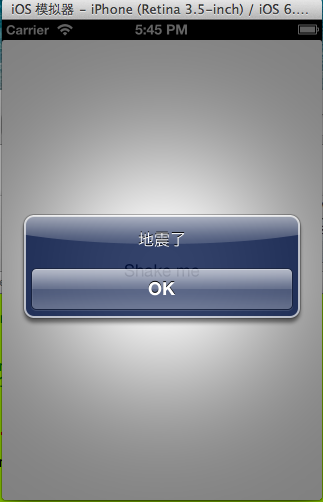您好,登录后才能下订单哦!
密码登录
登录注册
点击 登录注册 即表示同意《亿速云用户服务条款》
小编给大家分享一下IOS如何实现手机震动的提示功能,相信大部分人都还不怎么了解,因此分享这篇文章给大家参考一下,希望大家阅读完这篇文章后大有收获,下面让我们一起去了解一下吧!
IOS开发实现手机震动的提示实例代码
我们都知道手机有震动功能,其实呢,这个功能实现起来特别的简单,我们只需要用到几个函数就可以了:
- (void)motionBegan:(UIEventSubtype)motion withEvent:(UIEvent *)event - (void)motionEnded:(UIEventSubtype)motion withEvent:(UIEvent *)event - (void)motionCancelled:(UIEventSubtype)motion withEvent:(UIEvent *)event
还有就是通过canBecomeFirstResponder:设置一个第一响应者为label,然后摇动手机两下,看看效果如下:

代码如下:
HHLAppDelegate.h
#import <UIKit/UIKit.h> @class HHLViewController; @interface HHLAppDelegate : UIResponder <UIApplicationDelegate> @property (strong, nonatomic) UIWindow *window; @property (strong, nonatomic) HHLViewController *viewController; @end
HHLAppDelegate.m
#import "HHLAppDelegate.h"
#import "HHLViewController.h"
@implementation HHLAppDelegate
- (void)dealloc
{
[_window release];
[_viewController release];
[super dealloc];
}
- (BOOL)application:(UIApplication *)application didFinishLaunchingWithOptions:(NSDictionary *)launchOptions
{
self.window = [[[UIWindow alloc] initWithFrame:[[UIScreen mainScreen] bounds]] autorelease];
// Override point for customization after application launch.
self.viewController = [[[HHLViewController alloc] initWithNibName:@"HHLViewController" bundle:nil] autorelease];
self.window.rootViewController = self.viewController;
[self.window makeKeyAndVisible];
return YES;
}
- (void)applicationWillResignActive:(UIApplication *)application
{
// Sent when the application is about to move from active to inactive state. This can occur for certain types of temporary interruptions (such as an incoming phone call or SMS message) or when the user quits the application and it begins the transition to the background state.
// Use this method to pause ongoing tasks, disable timers, and throttle down OpenGL ES frame rates. Games should use this method to pause the game.
}
- (void)applicationDidEnterBackground:(UIApplication *)application
{
// Use this method to release shared resources, save user data, invalidate timers, and store enough application state information to restore your application to its current state in case it is terminated later.
// If your application supports background execution, this method is called instead of applicationWillTerminate: when the user quits.
}
- (void)applicationWillEnterForeground:(UIApplication *)application
{
// Called as part of the transition from the background to the inactive state; here you can undo many of the changes made on entering the background.
}
- (void)applicationDidBecomeActive:(UIApplication *)application
{
// Restart any tasks that were paused (or not yet started) while the application was inactive. If the application was previously in the background, optionally refresh the user interface.
}
- (void)applicationWillTerminate:(UIApplication *)application
{
// Called when the application is about to terminate. Save data if appropriate. See also applicationDidEnterBackground:.
}
@endHHLViewController.h
#import <UIKit/UIKit.h> @interface HHLViewController : UIViewController @end @interface LabelForMotion : UILabel @end
HHLViewController.m
#import "HHLViewController.h"
@interface HHLViewController ()
@end
@implementation LabelForMotion
- (BOOL)canBecomeFirstResponder
{
return YES;
}
@end
@implementation HHLViewController
- (void)viewDidLoad
{
[super viewDidLoad];
LabelForMotion *label = [[[LabelForMotion alloc]init]autorelease];
label.frame = self.view.bounds;
label.autoresizingMask =UIViewAutoresizingFlexibleWidth|UIViewAutoresizingFlexibleHeight;
label.textAlignment = NSTextAlignmentCenter;
label.text = @"Shake me";
[self.view addSubview:label];
//将标签设置为第一响应者
[label becomeFirstResponder];
[label release];
}
- (void)motionBegan:(UIEventSubtype)motion withEvent:(UIEvent *)event
{
NSLog(@"motionBegan");
}
//震动结束时调用的方法
- (void)motionEnded:(UIEventSubtype)motion withEvent:(UIEvent *)event
{
NSLog(@"motionEnded");
UIAlertView *alert = [[UIAlertView alloc]initWithTitle:nil message:@"地震了" delegate:nil cancelButtonTitle:nil otherButtonTitles:@"OK", nil nil];
[alert show];
[alert release];
}
- (void)motionCancelled:(UIEventSubtype)motion withEvent:(UIEvent *)event
{
NSLog(@"motionCancelled");
}
- (void)didReceiveMemoryWarning
{
[super didReceiveMemoryWarning];
// Dispose of any resources that can be recreated.
}
@end其实更简单的没有必要搞一个类继承自UIlabel,可以直接定义一个UIlabel的对象就行了。
以上是“IOS如何实现手机震动的提示功能”这篇文章的所有内容,感谢各位的阅读!相信大家都有了一定的了解,希望分享的内容对大家有所帮助,如果还想学习更多知识,欢迎关注亿速云行业资讯频道!
免责声明:本站发布的内容(图片、视频和文字)以原创、转载和分享为主,文章观点不代表本网站立场,如果涉及侵权请联系站长邮箱:is@yisu.com进行举报,并提供相关证据,一经查实,将立刻删除涉嫌侵权内容。